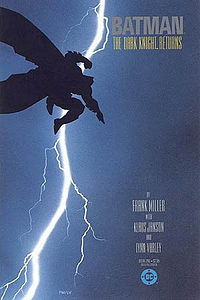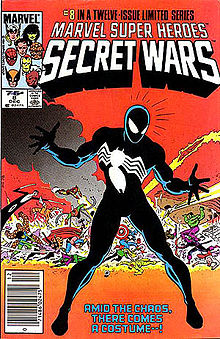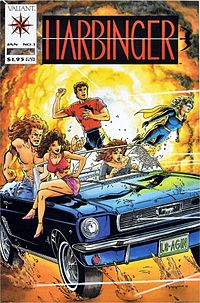- Modern Age of Comic Books
-
Modern Age of Comic Books 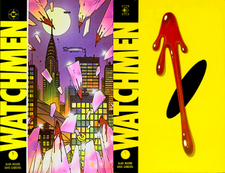
Watchmen (1986), one of the comics considered to signify the beginning of the Modern Age. Cover art by Dave Gibbons.Time span c.1985 — present Related periods Preceded by Bronze Age of Comic Books The Modern Age of Comic Books is an informal name for the period in the history of mainstream American comic books generally considered to last from the mid-1980s until present day.[1] In this period, comic book characters generally became darker and more psychologically complex, creators became better-known and active in changing the industry, independent comics flourished, and larger publishing houses became more commercialized.[citation needed]
An alternate names for this period is the Dark Age of Comic Books,[2] due to the popularity and artistic influence of grim titles, such as Batman: The Dark Knight Returns and Watchmen. Proponents of this view[who?] point out a wave of "Silver Age nostalgia" that first appeared during this time and has since permeated mainstream comic books.[citation needed]
Developments
Because the time period encompassing the Modern Age is not well defined, and in some cases disputed by both fans and most professionals, a comprehensive history is open to debate. Many influences from the Bronze Age of Comic Books would overlap with the infancy of the Modern Age. The work of creators such as John Byrne (Alpha Flight, Fantastic Four), Chris Claremont (Iron Fist, Uncanny X-Men), and Frank Miller (Daredevil) would reach fruition in the Bronze Age but their impact was still felt in the Modern Age. The Uncanny X-Men is the most definitive example of this impact as Bronze Age characters such as Wolverine and Sabretooth would have a huge influence on the Marvel Universe in the 1980s and beyond.
For DC, an event such as Crisis on Infinite Earths is the bridge that joins the two ages together. The result was the cancellation of The Flash (with issue 350), Superman (with issue 423), and Wonder Woman (with issue 329). The post-Crisis world would have Wally West as the new Flash, John Byrne writing a brand-new Superman series, and George Pérez working on a new Wonder Woman series. Batman would also get a makeover as the Batman: Year One storyline would be one of the most popular Batman stories ever published, with an animated adaptation of Year One released in 2011.
In rough chronological order by the beginning of the trend, here are some important developments that occurred during the Modern Age, many of which are interrelated:
Rise of independent publishers
The late 1970s saw famed creators going to work for new independent publishers. The arrival of Jim Shooter as Editor in Chief at Marvel Comics saw the departure of key creators at Marvel such as Steve Gerber, Marv Wolfman, and others. In these new companies (Pacific, Eclipse, First) creators were free to create very personal stories. Mike Grell's Jon Sable Freelance, Howard Chaykin's American Flagg!, Mike Baron and Steve Rude's Nexus, and Timothy Truman's GrimJack attracted some attention and garnered a number of awards. These creators were going to be attracted by DC editor Mike Gold to create defining works such as Green Arrow: The Longbow Hunters by Grell, Blackhawk by Chaykin, and Hawkworld by Truman. With Alan Moore, Frank Miller, and Art Spiegelman's Maus (which would later receive the Pulitzer Prize), this period marks the summit of the artform per comics expert Scott McCloud.
Fantasy, horror and "sophisticated suspense"
Horror and science fiction titles were absent from the mainstream comics market since the establishment of the restrictive Comics Code in the 1950s though independents like Gold Key comics did start doing horror titles as early as 1965. In the early 1970s, during the Bronze Age of Comic Books, Marvel revived these genres with their new fantasy and horror comics, including Conan the Barbarian by Roy Thomas, and The Tomb of Dracula. Steve Gerber’s work on Man-Thing and Howard the Duck was also very influential in this period based on its philosophical impact of questioning society. These titles would be the foundation for what was to come in the mid-1980s (the beginning of the Modern Age).
Starting with Alan Moore’s groundbreaking work on DC Comics's Swamp Thing in the early 1980s, horror comic books incorporated elements of science fiction/fantasy and strove to a new artistic standard. Other examples include Neil Gaiman’s The Sandman (followed a few years later by Garth Ennis and Steve Dillon’s Preacher). These new comics transcended easily identifiable genres.
Striving to apply some label to these titles, some of which did have at a similar feel and approach, some people began to use the phrase "sophisticated suspense".[citation needed] DC’s Vertigo line, under the editorship of Karen Berger, was launched in 1993, with the goal of specializing in this genre.
Existing titles such as Animal Man, Doom Patrol, Hellblazer, and Shade, the Changing Man were absorbed into this new line. Later in the decade, popular titles such as The Books of Magic, The Dreaming, The Invisibles, Lucifer, and Sandman Mystery Theatre would continue to exert Vertigo’s influence. Vertigo would prove to be a very influential line of comics as it would continue to be published into the 21st Century. Titles such as 100 Bullets, American Virgin, Fables, Y: The Last Man, and the publishing of Harvey Pekar’s American Splendor would cement Vertigo’s reputation as a viable alternative to the superhero genre.
During the 2000s, a number of successful movie adaptations of comic books, partly due to improvements in special effect technology, helped to extend their market audience, attracting the attention of many new readers who previously had not been interested in comic books. This also lead to an avalanche of other comic book adaptations which included previously lesser known Vertigo titles, notably Constantine (based on the comic book Hellblazer) and V for Vendetta.
The rise of anti-heroes
In the mid 1970s, Marvel anti-heroes such as the X-Men’s Wolverine, the Punisher and writer/artist Frank Miller’s darker version of Daredevil challenged the previous model of the superhero as a cheerful humanitarian. Miller also created Elektra who straddled the conventional boundary between love interest and villain.
Two artistically influential DC Comics limited series contributed to the trend: Batman: The Dark Knight Returns, also by Frank Miller and Watchmen by Alan Moore and Dave Gibbons, both of which were series of impressive psychological depth that starred troubled heroes.
By the early 1990s, anti-heroes had become the rule rather than the exception, and among the most popular were Marvel comics' Cable and Venom and Image Comics' Spawn, although some fans complained that too many of them were unlikable psychopaths of little depth and originality.[citation needed]
Some critics believe that this trend was a move towards emotional realism, where the idea of a person selflessly using their extraordinary abilities on a quest for good was no longer believable, but a person with a deep psychological impulse to destroy criminals was.[citation needed]
The trend of creating characters with more psychological depth that were less black-and-white also affected supervillains. For example, the Joker, Batman's nemesis, was portrayed less as an evil criminal and more as a mentally ill psychopath who can't control his actions, Marvel Comics' galactic planet-eater Galactus became a force of nature who means no personal malice in his feedings, and the X-Men's nemesis Magneto became more benign and sympathetic as a man who fights for an oppressed people, albeit through means others deem unacceptable.
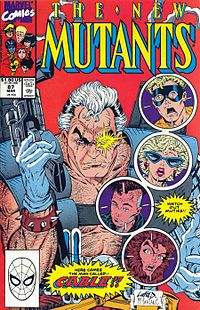 The cover of New Mutants (vol. 1) #87 featuring the first appearance of Cable. Art by Rob Liefeld and Todd McFarlane.
The cover of New Mutants (vol. 1) #87 featuring the first appearance of Cable. Art by Rob Liefeld and Todd McFarlane.
Development of the X-Men franchise
By the mid-1980s, X-Men had become one of the most popular titles in comics. Marvel decided to build on this success by creating a number of spin-off titles, sometimes collectively referred to as "X-Books". These early X-Books included New Mutants (which would later become X-Force), X-Factor, Excalibur, and a Wolverine solo series.
By the early 1990s, X-Men had become the biggest franchise in comics, and by the middle of the decade over a dozen X-Men-related comic books, both continuing and limited series, were published each month. On an almost annual basis from 1986 until 1999, one storyline crossed-over into almost every X-Book for two to three months. These "X-Overs" usually led to a spike in sales.
This sales boom resulted in a great deal of merchandising, such as action figures, video games and trading cards. This success was thanks in no small part to the Fox Network's animated X-Men series, which debuted in 1992 and drew in a large number of younger fans.
The sales boom began to wane in the mid to late 1990s, due to the crash of the speculators market and the effect it had on the industry. Marvel declared bankruptcy, and as a result, scaled back all of their franchises, including X-Men. A number of "X-books" were canceled, and the amount of limited series published, as well as general merchandise, was reduced.
In the early 2000s, a series of blockbuster X-Men movies have kept the X-Men franchise healthy, and have resulted in a larger market presence outside of comics. In 1999-2000, a new animated series, X-Men: Evolution debuted, while new toys have been developed and sold since the success of the first X-Men feature film. The comic books themselves have been reinvented in series such as Grant Morrison's New X-Men and the Ultimate X-Men, which, like Marvel's other "Ultimate" series, is an alternate universe story, starting the X-Men tale anew. This was done for X-Men, and other books, because Marvel feared that the long and complex histories of the established storylines of certain titles were scaring off new readers.
Effect on other comics
The success of the X-Men had several effects on the comic book industry. Series featuring superhero teams, especially ones in which internal friction contributed to storylines, became much more common.[citation needed] DC Comics's The New Teen Titans series of the 1980s show the influence of the X-Men as do 1990s Image Comics teams such as Youngblood, WildC.A.T.s, and Gen¹³. By the peak of the X-Men's popularity in the early 1990s, the team's chemistry was often imitated and many series featured Cyclops, Wolverine, Storm and Rogue styled characters.
Also, many series tried to imitate the model the X-Men carved as a franchise. Marvel and DC expanded popular properties, such as Punisher, Spider-Man, Batman, and Superman into networks of spin-off books in the mid-to-late 1980s. Like the X-Books, some of these spin-offs highlighted a concept or supporting character(s) from a parent series, while others were simply additional monthly series featuring a popular character. In another similarity to the X-Books, these franchises regularly featured crossovers, where one storyline overlapped into every title in the “family” for a few months.
With regards to storylines overlapping, the Superman stories from 1991–2000 were written on a weekly basis. One needed to buy Superman, Adventures of Superman, Action Comics, and Superman: The Man of Steel (and eventually, Superman: The Man of Tomorrow) to keep up with any existing storylines. If a collector only bought Action Comics, they would only get twenty-five percent of the story. A triangle was featured on the cover of every Superman title with a number on it. This number indicated which week of the year the Superman title was released.
Makeovers and universe reboots
Complementing the creation of these franchises was the concept of redesigning the characters. The Modern Age of comics would usher in this era of change. The impact of Crisis on Infinite Earths was the first example as Supergirl died in issue 7, and long-time Flash (Barry Allen) died in issue 8. Specifically, Barry Allen signified the beginning of the Silver Age of Comics and his death was highly shocking at the time. Marvel Comics' Secret Wars would usher in a new change as well as Spider-Man would wear a black costume.
The interest in the speculator market of a new Spider-Man costume led to other changes for Marvel characters in the 1980s. Iron Man would have a silver and red armor in issue 200. Captain America would be fired and would be reborn as the Captain, wearing a black outfit in issue 337 of the series. The Incredible Hulk would revert to his original Grey skin color in issue 325. Issue 300 of the first Avengers series resulted in a new lineup including Mister Fantastic and the Invisible Woman, of the Fantastic Four.
The 1990s would bring similar changes to the DC Universe, including the death of Superman in 1992 and the Knightfall storyline in Batman comics, during which Azrael became the new Batman.[3] Wonder Woman lost a challenge and Diana was replaced by Artemis as the new Wonder Woman[4] until her death in issue 100. Guy Gardner went from being a Green Lantern to drinking from a chalice in a cave and becoming Warrior. The only change that would last for more than ten years was when Hal Jordan became Parallax and killed off all the Green Lanterns, resulting in Kyle Rayner becoming the new Green Lantern in issue 50 of the second series.
In addition to individual character or franchise/family wide makeovers, Crisis on Infinite Earths ushered in a popular trend of "rebooting", "remaking", or seriously reimagining the publisher wide universes every 5–10 years on varying scales. This often resulted in origins being retold, histories being rewritten, and so forth. These reinventions could be on as large a scale as suddenly retconning seminal story points and rewriting character histories, or simply introducing and/or killing off/writing out various important and minor elements of a universe. Crisis on Infinite Earths resulted in several miniseries' which explicitly retconned character histories, such as Batman: Year One, Superman: Man of Steel, and Wonder Woman: Gods and Mortals. An example of a less ambitious scale of changes is Green Arrow: The Longbow Hunters, which did not explicitly retcon or retell Green Arrow's history, but simply changed his setting and other elements of the present, leaving the past largely intact. This trend of publisher wide reinventions, which often consists of a new miniseries and various spinoff storylines in established books, continues today, with DC's recent Infinite Crisis and the spinoff storylines - One Year Later, 52, and Countdown to Final Crisis - and Marvel's House of M and Civil War storylines, the results of which are still being felt in the Marvel Universe.
Image Comics and creator rights disputes
In the mid-1980s, artist Jack Kirby, co-creator of many of Marvel's most popular characters, came into dispute with Marvel over the disappearance of original pages of artwork from some of his most famous titles. Alan Moore, Frank Miller, and many other contemporary stars became vocal advocates for Kirby.
By the early 1990s, these events, as well as the influence of vocal proponents of independent publishing, helped to inspire a number of Marvel artists to form their own company, Image Comics, which would serve as a prominent example of creator-owned comics publishing. Marvel artists such as X-Men’s Jim Lee, The New Mutants/X-Force’s Rob Liefeld and Spider-Man’s Todd McFarlane were extremely popular and were idolized by younger readers in ways more common to professional athletes and rock musicians than comic book artists. Propelled by star power and upset that they did not own the popular characters they created for Marvel, several illustrators, including the above three formed Image Comics in 1992, an umbrella label under which several autonomous, creator-owned companies existed.[5] Image properties, such as WildC.A.T.s, Gen¹³, Witchblade and especially McFarlane’s Spawn provided brisk competition for long-standing superheroes. However, many criticized Image for prioritizing flashy artwork and cheap gimmicks over storytelling and originality.[citation needed] Image in particular is singled out by some critics for contributing to the conditions which led to the speculator market crashing, as Image titles favored alternative covers, foil covers, and other "collectible" comics.[6]
Many popular creators followed Image's lead and attempted to use their star power to launch their own series; ones for which they would have licensing rights and editorial control. Chris Claremont, famous for his long run as the writer of Uncanny X-Men, created Sovereign Seven for DC; Joe Madureira, also made popular by Uncanny X-Men, launched Battle Chasers for WildStorm Productions; and Kurt Busiek, Alex Ross, and Brent Anderson created Astro City for Image.
Valiant Comics
Valiant Comics was one of the largest companies in the American comic book market during the 1990s, initially packaging specialty comics and going on to sell more than 80 million comic books in its first five years. Its characters have seen print in a number of languages internationally and have been featured in video games that have sold over 10 million units.
In 1988, former Marvel Editor-In-Chief Jim Shooter and a group of other investors attempted to purchase Marvel Comics. Shooter's group submitted the second highest bid, but ultimately investor/entrepreneur Ronald Perelman wound up submitting the highest bid to purchase the company. Steven Massarsky, former manager of the Allman Brothers Band, and Shooter then convinced a venture capital firm, Triumph, to back their creation of a new comics publisher. They founded Voyager Communications Inc. and its comic-book publishing imprint, Valiant Comics, and hired Bob Layton away from Marvel to help with its planned superhero line. Voyager/Valiant licensed three dormant properties from 1960s and 1970s publisher Gold Key Comics: Magnus Robot Fighter; Doctor Solar; and Turok Dinosaur Hunter.
In 1990, Valiant launched its superhero line, mixing modified versions of the Gold Key characters with several original titles and characters such as Archer and Armstrong, Eternal Warrior, Harbinger, Rai, Shadowman, and X-O Manowar, to establish a new shared universe. In mid-1992, the company published a line-wide crossover called Unity. By producing unique characters, Valiant quickly developed a passionate fanbase. Through word of mouth and marketing, the popularity of the company grew. Publications like the Overstreet Comic Book Price Guide and Wizard magazine took notice of Valiant's success, specifically the escalating demand for rarer pre-Unity books that established the new universes origins and featured the first appearances of its characters.
Despite this burgeoning success, Shooter's security within the company was not ensured. His relationship with Triumph had been badly damaged and he reportedly resisted his partners' plans to position the company for a rapid sale. This dispute led to Shooter's dismissal.[7] Bob Layton then took over the bulk of Shooter's duties in publishing operations while Kevin VanHook became Executive Editor. Valiant greatly expanded its comics line and soon became the #3 comic book publisher in terms of market share, behind only industry giants Marvel and DC. In 1993, the first issue of Turok Dinosaur Hunter sold 1.75 million copies. This was one of a series of highly successful books that cemented Valiant's place as an industry heavyweight — Bloodshot #1 sold 900,000 copies, X-O Manowar #0 sold 850,000, Rai #9 sold 800,000, Ninjak #1 sold 500,000, etc.[citation needed]
A year later, in June 1994, Voyager Communications, Inc. was sold to the video game giant Acclaim Entertainment for $65 million.[8] Along with the rest of the comics industry, Valiant's sales soon slumped as the speculative boom collapsed,[9] and Acclaim management took a more active role in publishing decisions.
In 1996, Acclaim relaunched the Valiant Comics line as Acclaim Comics. Their primary motivation was to make the properties more suitable for use in video game development. This led to the creation of the Shadowman and Turok Dinosaur Hunter video game franchises.
In 1999, Acclaim began publishing "Unity 2000," written by a returning Shooter, that was supposed to integrate the old Valiant universe and new Acclaim Universe. However, Shooter used the high profile book as an opportunity to strike back at his former partners, creating a group of new villains who mimicked their looks and personalities.[citation needed] Additionally, Acclaim failed to market the books but, nevertheless, saw a good deal of interest on the issues that saw print. Acclaim was forced to stop the series after only three issues because of an art return fiasco with Jim Starlin (artist on the series) and a payment problem with Shooter. The company ceased all publication two months later to focus on its faltering core businesses.
In 2004, Acclaim filed for bankruptcy and shut down its offices.
The rise and fall of the speculator market
By the late 1980s, important comic books, such as the first appearance of a classic character or first issue of a long-running series, were sold for thousands of dollars. Mainstream newspapers ran reports that comic books were good financial investments and soon collectors were buying massive amounts of comics they thought would be valuable in the future.
Publishers responded by manufacturing collectors’ items, such as trading cards, and “limited editions” of certain issues featuring a special or variant cover. The first issues of Marvel Comics' X-Force, X-Men, vol. 2 and Spider-Man became some of the first and most notorious examples of this trend. Another trend which emerged was foil-stamped covers. The first Marvel comic book with a foil-stamped cover was the second volume of the Silver Surfer, issue 50. A glow-in-the-dark cover for Ghost Rider, volume 2, issue 15 appeared as well. This led a market boom, where retail shops and publishers made huge profits and many companies, large and small, expanded their lines. Image Comics in particular became notorious for this, with many of its series debuting with alternative covers, wide use of embossed and foil covers and other "collectible" traits.
This trend was not confined to the books themselves, and many other pieces of merchandise, such as toys, particularly "chase" action figures (figures made in smaller runs than others in a particular line), trading cards, and other items, were also expected to appreciate in value. McFarlane Toys was notable for this, as it created many variations in its high-quality toys, most of which were main characters or occasional guest stars in the Spawn series.
But few, in the glut of new series, possessed lasting artistic quality and the items that were predicted to be valuable did not become so, often because of huge print runs that made them commonplace. A crash occurred, sales plummeted, hundreds of retail stores closed and many publishers downsized. In 1996, Marvel Comics, the largest company in the industry, declared bankruptcy (it has since rebounded). The industry has still not yet fully recovered from the speculator crash.
The crash also marked the relative downfall of the large franchises, inter-connected "families" of titles that lead to a glut of merchandising. While the big franchise titles still have a large amount of regular titles and merchandising attached to them, all of these things were notably scaled back after the crash. Several franchises have once again gained prominence, such as the X-Men, due in large part to the feature films X-Men and X2, and many DC heroes thanks to the success of various animated series' based on their characters, such as Justice League, Justice League Unlimited, and Teen Titans.
The rise of the trade paperback format
Although sales of comic books dropped in the late 1990s and the early 2000s, sales rose for trade paperbacks, collected editions in which several issues are bound together with a spine and often sold in bookstores as well as comic shops.
Some series were saved from cancellation solely because of sales of trade paperbacks, and storylines for many of the most popular series of today (DC’s JLA and various Batman series and Marvel’s Ultimate Spider-Man and New X-Men) are put into trade paperback instantly after the storyline ends.
Trade paperbacks are often even given volume numbers, making them a serializations of sorts. Due to this, many writers now consider their plots with the trade paperback edition in mind, scripting stories that last four to twelve issues, which could easily be read as a “graphic novel.”
The popularity of trade paperbacks, has resulted in older material being reprinted as well. The Essential Marvel line of trade paperbacks has reprinted heroes such as Spider-Man and the Fantastic Four and has been able to introduce these Silver Age stories to a new generation of fans. These editions tend to resemble a phone book in that these are very thick books and are black-and-white (to help keep the cost down).
DC Comics has followed suit by introducing a line called Showcase Presents. The first four have included Superman, Green Lantern, Jonah Hex, and Metamorpho the Elemental Man. Other characters have included Green Arrow, The Superman Family, the Teen Titans and the Elongated Man.
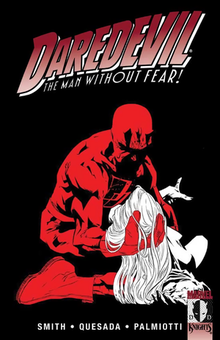 The death of Karen Page. Promotional art for Daredevil Visionaries: Kevin Smith by Joe Quesada and Jimmy Palmiotti.
The death of Karen Page. Promotional art for Daredevil Visionaries: Kevin Smith by Joe Quesada and Jimmy Palmiotti.
Comics creators' mainstream success
While many comic-book artists, and writers had become well-known by their readership as early as the 1940s, some comics creators in the late 1980s and the 1990s became known to the general population. These included Todd McFarlane, Neil Gaiman, Alan Moore, and Frank Miller. Some, such as Gaiman, went on to write critically and commercially successful novels. Others, like Miller, became Hollywood screenwriters and directors.
Conversely, film and TV directors and producers became involved with comics. J. Michael Straczynski, creator of TV's Babylon 5, was recruited to write Marvel Comics' The Amazing Spider-Man and, later Fantastic Four Filmmaker Reginald Hudlin became the writer of Marvel's Black Panther. Joss Whedon, creator of TV's Buffy the Vampire Slayer, wrote Marvel's Astonishing X-Men and Runaways, among other series. Richard Donner, who directed the Superman films of the 1970s and 1980s, became a writer on the Superman feature in Action Comics in 2006, co-writing with comics writer (and Donner's former production assistant) Geoff Johns. Paul Dini, producer and writer of Batman: The Animated Series and Superman: The Animated Series, started writing for DC in 1994 on special projects and took the helm as writer of Detective Comics in 2006.
Comics writer Peter David's career as a novelist developed concurrently with his comic-book career.[10][11] Sandman writer Neil Gaiman has also enjoyed success as a fantasy writer and number one New York Times Bestseller. Michael Chabon who won the Pulitzer Prize with The Amazing Adventures of Kavalier and Clay, a novel about the start of the Golden Age of Comic Books, then went on to write comics for DC and Dark Horse. Novelist Brad Meltzer saw success in the comics field with the controversial miniseries Identity Crisis, as well as runs on Green Arrow and Justice League of America.
Return to earlier genres
In 1993, Alan Moore decided to undo the changes he had brought about with Watchmen and created 1963. He wasn't the first since, already in the eighties, John Byrne, Roger Stern, Paul Smith and Tom DeFalco had tried to restore Silver Age elements. Since then many creators, including Kurt Busiek, Mark Waid, Michael Allred, Alex Ross, Grant Morrison, Geoff Johns and Jeff Parker have created comics harking back to earlier periods in style, characters or storytelling.
The influence of Japanese comics and animation
The mid to late 1980s would see the quiet introduction of various translated Japanese manga into North America. While not the first company to release translated manga, the first company to do so to a large degree was Eclipse which introduced Area 88, Legend of Kamui, and Mai the Psychic Girl, the three titles that are generally associated with the first wave of manga translated into English. Along with Comico and Eternity Comics's adaptation of the Robotech animated series, various other companies would release manga style comics such as Ben Dunn's Ninja High School and Barry Blair's Samurai. Dark Horse Comics would release many translated manga during the 1990s. Marvel's Epic Comics line would also license an English translation of Katsuhiro Otomo's Akira. As of the 2010s, most translated manga are distributed by subsidiaries of the original Japanese property owners, such as Kodansha, Shogakukan or Bandai. While manga translations were previously presented in the traditional American comic magazine format, most[citation needed] now appear in the digest size publications traditional to manga. In some cases, the books are presented in the original form intended to be read from right to left.
See also
- Events from the Modern Age of Comic Books
- Portrayal of women in comic books
Notes
- ^ Overstreet Comic Book Price Guide 2008 #38, page 1028, Glossary of terms.
- ^ Voger, Mark (2006)
- ^ (see Batman #500).
- ^ (see issue 92)
- ^ "Bye Bye Marvel; Here Comes Image: Portacio, Claremont, Liefeld, Jim Lee Join McFarlane's New Imprint at Malibu," The Comics Journal #148 (February 1992), pp. 11-12.
- ^ "Newswatch: Industry Sales Records in 1993 Shadowed by Collapse of Speculator Boom: Image Receives Brunt of Criticism for Their Role in Market Crash," The Comics Journal #166 (February 1994), pp. 27-33.
- ^ "NewsWatch: Voyager Fires Jim Shooter," The Comics Journal #151 (July 1992), p. 15.
- ^ "Newswatch: Acclaim Buys Voyager for $65 Million," The Comics Journal #168 (May 1994), p. 31.
- ^ "News Watch: Acclaim Entertainment Tanks Hard in Fourth Quarter of 1996," The Comics Journal #192 (Dec. 1996), p. 29.
- ^ "Peter David. "WHAT’CHA WANNA KNOW?" peterdavid.net; October 21, 2003". Peterdavid.net. http://www.peterdavid.net/index.php/2003/10/21/whatcha-wanna-know-3/. Retrieved 2009-09-10.
- ^ "R.J. Carter. "Interview: Peter David: An Apropos Conversation" The Trades; August 14, 2002". The-trades.com. 2002-08-14. http://www.the-trades.com/article.php?id=1306. Retrieved 2009-09-10.
References
- Voger, Mark (2006). The Dark Age: Grim, Great & Gimmicky Post-Modern Comics. TwoMorrows Publishing. ISBN 1-893905-53-5.
External links
- Very Fine / Near Mint nostalgia blog (Defines the "Copper Age" as spanning from 1984–1991, and includes a List of Key Copper Age Comics.)
Comics: Genres & themes Formats Comic book (minicomic) · Comic strip (Comic strip formats, Daily strip, Sunday comics, Sunday strip, Topper) · Digital comics · Graphic novel · Mobile comic · Motion comics · Trade paperback · Webcomic (Hypercomics · Infinite canvas · Sprite comic)
Creators Category:Comics artists · Category:Comics writersStudies History in the U.S.: Golden Age, Silver Age, Bronze Age, Modern Age (Events) · History in Japan · Women in comics · LGBT themes in comicsGenres Adult comics · Alternative comics · Autobiographical comics · Bad girl art · Crime comics · Fantasy comics · Funny animal · Good girl art · Horror comics · Romance comics · Science fiction comics · Superhero comics · Teen humor comics · Underground comix · War comics · Western comicsTropes  PortalCategories:
PortalCategories:- History of comics
- Modern Age of Comic Books
Wikimedia Foundation. 2010.

